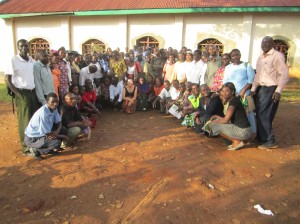Operations Room

The One Million Community Health Workers (1mCHW) Campaign has embarked on a novel initiative to work with a variety of partners on scaling up CHW programs throughout sub-Saharan Africa. In order to maintain sufficient data on these efforts we have already begun our count to one million community health workers. The Operations Room is a CHW Registration platform meant to aid in this work. First, we thank all of the Ministries of Health, Civil Society Organizations (CSOs), UN agencies, and bilateral agencies that have contributed data to the Operations Room. So far, we’ve counted approximately 133,000 CHWs and have data on 15 countries across sub-Saharan Africa.
The Operations Room is part of the larger Campaign effort to scale up 1 million CHWs in sub-Saharan Africa to achieve the Millennium Development Goals, Universal Health Coverage and overall health systems strengthening.
Why 1 million, you ask? A CHW Technical Task Force commissioned by the Earth Institute in 2011 agreed that there will be a total of 1 million CHWs needed (1 CHW per 500 people) to achieve systematic Human Resources for Health (HRH) coverage of the low-income, rural sub-Saharan African population of 500 million by 2015. The Campaign was set up to support sub-Saharan African governments reach this number.
Last year, when the 1mCHW Campaign set out to assess the need, we were stumped. What is the current gap of deployed CHWs in sub-Saharan Africa ? The calculation is straightforward: 1,000,000 – current # of CHWs deployed and active = CHWs needed to fill HRH gap. But, we found that it is rather difficult to count the number of CHWs that are currently deployed and active in the field. Resource-limited federal and state governments face challenges in managing large cadres of public sector CHWs and CSOs’ hands are often tied when it comes to tracking government-trained cadres. Where tracking exists, data are often elusive and inaccurate and exist mostly in the form of excel files, which are shared haphazardly among insider groups.
The 1mCHW Campaign offers a stopgap measure through the Operations Room to register CHWs, establish initial counts, and advance preparations for rolling out identified interventions for upgrading and expanding extant CHW cadres. As the word “stopgap” suggests, the Operations Room is not the perfect solution. It is in phase 1 of a 3-phase development process to eventually establish a global and country-specific CHW information platform that is linked to national health information systems and m/e health platforms that allows for real-time monitoring of CHW programs across sub-Saharan Africa.
As the Campaign wrestles with how to count CHWs, others often ask us:
1. How do you define CHWs?
2. How do you avoid double, triple, quadruple counting?
3. Are you collecting aggregate numbers or counting individuals?
4. How do you validate data?
These are all questions that through the next few months, the Campaign will provide some insight into. To our best knowledge, we are unaware of other organizations that are systematically counting CHWs. However, if you also share our vision, please reach out to me at sjkim@ei.columbia.edu! If you would like to contribute to the count, 15 minutes of your time is all we need.
For the month of February, we will be featuring blog posts written by organizations working in Liberia, Kenya, Tanzania among others to share their experiences of counting and managing CHWs. Please check back for more stories and updates on the Operations Room and learn about how other organizations and countries are tackling the issue of counting 1 million CHWs with the 1mCHW Campaign.

Comments are closed